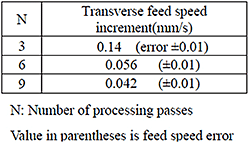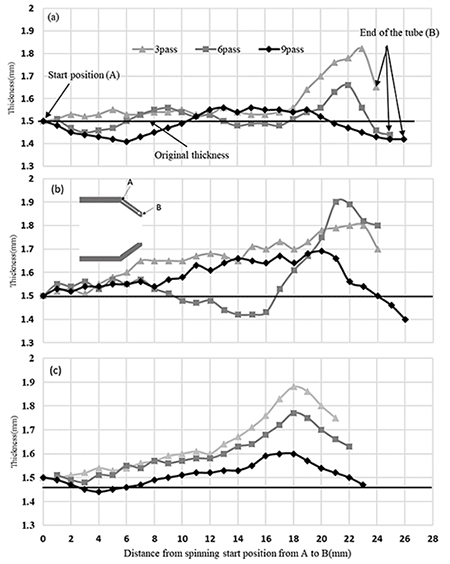The spinning process is a plastic working that presses a roller tool to change the wall thickness of the material with rotating a plate or tube materials. The shear spinning can be formed in a single pass in the form of a die by moving the roller along the side surface of the die, and a uniform thickness can be obtained. Conventional spinning is characterized by gradually changing the outline by repeating movement of the rollers, with little change in plate thickness.
Examples of spinning applications include automotive wheels, parabolic antennas, high pressure hydrogen storage containers. For the production of the high-pressure hydrogen storage container, hot spinning processing is performed. As an aluminum liner material for a high pressure hydrogen storage container, an Al-Mg-Si alloy is used from the viewpoint of hydrogen embrittlement resistance and strength. The liner material is reinforced with expensive carbon fiber reinforced plastic (CFRP). However, internal defects such as wrinkles that occur when these alloys are hot spinning have become problems. Since the container repeats filling and discharging such as under a fatigue environment, and internal defects can be caused breakage. So far, few reports have investigated the influence of hot spinning processing conditions on inner surface defects. Our research group have investigated the influence of processing conditions in cold spinning formability of Al-Mg-Si alloy tube. In addition, the high temperature tensile properties of Al-Mg-Si based alloys has been investigated, and it is reported that the maximum stress decreases greatly, and the strain increase as the temperature increase. However, actual container is processed by hot spinning, so it is necessary to study on hot spinning. In this study, the effect of spinning conditions and processing temperature on hot spinning workability of Al-Mg-Si alloy is investigated.
As a specimen, a commercially available material of an Al-Mg-Si alloy tube material (A6063) with an outer diameter 50mm, a thickness 1.5mm, and a length L=68mm was used. Table 1 shows the chemical composition of the specimen.
The processing temperature was changed to three conditions of 200°C, 300°C, and 400°C, and processing was carried out. In addition, in order to investigate the influence of processing conditions on workability, processing was performed by changing the number of passes until reaching the target shape to 3 kinds, 3, 6 and 9 passes. Table 2 shows detailed spinning processing conditions, and Table 3 shows feeding speeds that change according to the number of passes. In the heating method of the specimen, the specimen was attached to the jig and heated while burning while rotating it, and the temperature was measured with a thermocouple. After raising the temperature to the target temperature, perform processing and heat again every pass. The heating time to 200°C was 20 minutes, 300°C was 40 minutes, and 400°C was 80 minutes. The temperature drop per pass was about 30°C, and the reheating time per pass was about 5 minutes. The thickness of the test piece after processing is measured with a micrometer on the tip of the needle. The test piece for observation of internal defects was cut from processed specimen at near the tip with a large processing amount. Internal defects were observed at the inner surface of the test piece using a laser microscope.
In results, the length of the processing section increases with increasing in number of passes and decreasing in processing temperature. Figs. 1(a), 1(b), and 1(c) show the results of measuring the wall thickness change with a needle tip-like micrometer after processing at processing temperatures of 200°C, 300°C, and 400°C, respectively. The rough tendency is that the wall thickness decreases with increasing in number of passes and decreasing in processing temperature.
In the results of measurement of the unevenness on the rear surface of the specimen after processing with a laser microscope, although the unevenness change at 200°C does not differ so much as the number of passes, machining at 300°C and 400°C has large unevenness change, and as the number of passes decreases further, unevenness become larger. The effects of the temperature and the number of passes on the internal surface defect is found that the unevenness of the inner surface tended to increase as the pass number is small and the processing temperature is higher.
The Al-Mg-Si alloy tube material (A6063) was subjected to hot spinning at different processing conditions and processing temperature to evaluate its spinning workability. The primary results are follows:
| (1) | The higher the temperature and the smaller the number of passes, the wall thickness increases easily. It is considered that the yield stress of the material is lowered by elevating the temperature, and the material tends to be locally deformed without work hardening. And the flowed material and extend part of specimen by spinning increase with increase in the number of passes. | |
| (2) | The unevenness of the inner surface tended to increase as the pass number was small, and the processing temperature was higher. In higher temperature spinning, it is considered that the large compressive plastic deformation occurs at the roller contact portion. And in the small number of passes, the large compressive plastic deformation is occurred per one pass during spinning. | |
| (3) | Therefore, the better spinning condition is seemed that the number of pass is 6 and spinning temperature is 400°C. |


